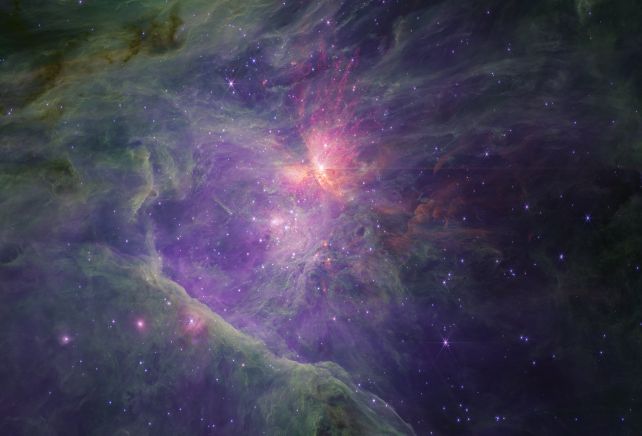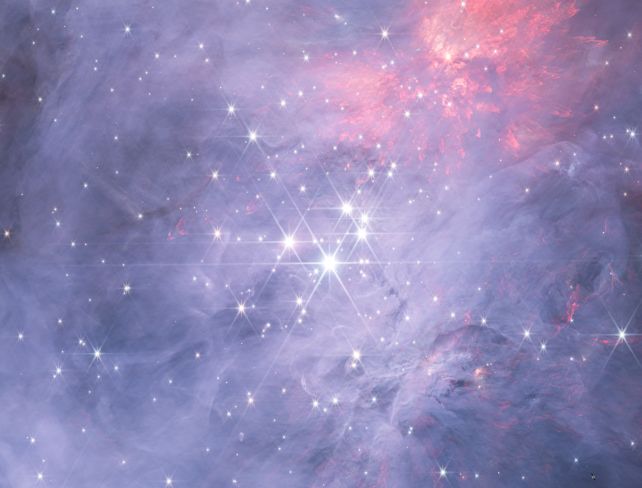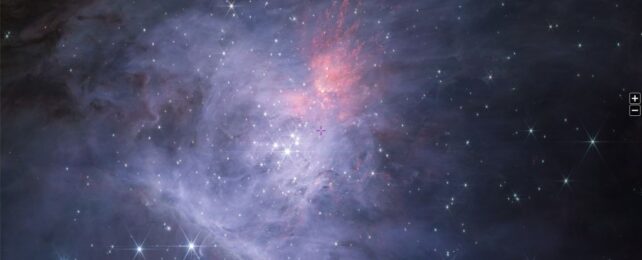JWST observations of the star-forming heart of the Orion nebula have given us something we've never seen before.
There, in the Trapezium cluster, scientists have found dozens of planet-like objects roughly the mass of Jupiter untethered to any star, drifting through the galaxy in gravitationally-bound pairs like it's a perfectly normal thing to do.
But it isn't. There is no known formation mechanism that can lead to these binary masses – never mind 42 of them.
As we find more and more alien worlds in the Milky Way, though, it becomes more and more clear that our understanding of the birth of planets has some serious holes. So, what these objects are, and where they come from, could help us learn more about how stars and planets form.
Astronomers Samuel Pearson Mark McCaughrean of the European Space Agency have named them Jupiter Mass Binary Objects, or JuMBOs, and described them in a preprint paper that has been submitted to Nature.

It's thought that such star-forming environments might be riddled with what we call rogue exoplanets – those that have become unmoored from their stars. That's because so many stars in close proximity to each other can disrupt each other's baby planetary systems. Simulations suggest that rogue exoplanets could be incredibly common.
In addition, the existence of planet-mass objects free-floating in Orion is not a surprise. Astronomers have been detecting them for decades, down to a mass of about three times that of Jupiter.
But for objects any smaller than that in Orion, detection is a huge challenge. The background of Orion is very bright; and small, planet-mass objects are relatively cool, emitting most of their light in thermal infrared.
This, however, is where JWST shines. Built to detect infrared light, the powerful space telescope has given us the most detailed observations of Orion ever taken.
So Pearson and McCaughrean went looking for tiny things. But what they found defied expectation.
"We were looking for these very small objects and we find them. We find them down as small as one Jupiter mass, even half a Jupiter mass, floating freely, not attached to a star," McCaughrean told Hannah Devlin at The Guardian.
"Physics says you can't even make objects that small. We wanted to see, can we break physics? And I think we have, which is good."
The JuMBOs are about a million years old, with temperatures hovering around 1,000 Kelvin (roughly 700 degrees Celsius) and orbital separations ranging between 25 and 390 times the distance between Earth and the Sun. Analysis of the faint light they give off reveals hints of water vapor, carbon monoxide, and methane. So far so normal for a baby gas giant.
The problem with the JuMBOs is the fact they come in twos. A lone rogue exoplanet doing its own thing is one thing. But two gravitationally bound planet-mass objects are really hard to explain.

Stars, you see, form when a clump of material in a molecular cloud collapses under gravity. As they spin, they draw in more material from the cloud around them, which forms a disk feeding into the star. During this process, the disk can break, resulting in the formation of a second star; thus a binary star is born.
But the theoretical lower mass limit for an object forming via this cloud-collapse formation scenario is about three Jupiter masses. Smaller objects like planets form in the disk of material around the star.
Simulations suggest these baby planets can get kicked out of their systems really easily, either by planet-planet or star-star interactions. But the mechanisms involving this ejection are not conducive to pairs of planets staying together.
It's possible that lone, ejected planets could find each other and become gravitationally bound, but we'd expect that to be pretty rare. To spot 42 of these pairs, as laid out in the paper by Pearson and McCaughrean, suggests that there is something fundamental that we're missing.
"How pairs of young planets can be ejected simultaneously and remain bound, albeit weakly at relatively wide separations, remains quite unclear," the researchers write in their paper.
"The ensemble of planetary mass objects and JuMBOs that we see in the Trapezium Cluster might arise from a mix of both of these "classical" scenarios, even if both have significant caveats, or perhaps a new, quite separate formation mechanism, such as a fragmentation of a star-less disk, is required."
The study describing JuMBOs is available on preprint server arXiv.org.
